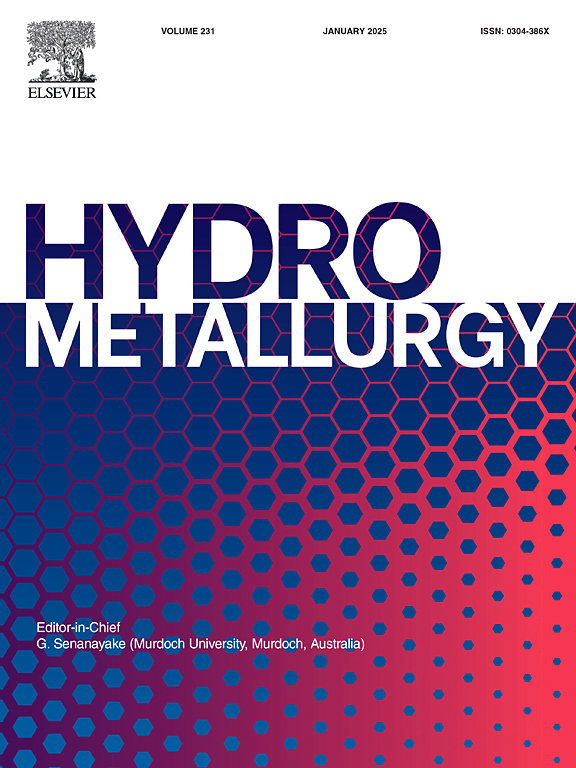Recovery of valuable metal products from the leach residue of sedimentary rare earth ore by acid leaching and precipitation
IF 4.8
2区 材料科学
Q1 METALLURGY & METALLURGICAL ENGINEERING
引用次数: 0
Abstract
The residue produced after extracting rare earth elements from sedimentary rare earth ore (SREO) contains valuable metals. The effective separation and extraction of valuable metals from this residue is crucial for enhancing the utilization value of SREO and addressing the challenges associated with solid-waste disposal. In this study, Al and Fe were leached from SREO residue using a mixture of sulfuric and phosphoric acids. The leach residue was subsequently subjected to sulfuric acid curing and dilute acid leaching to extract Ti. Results showed that the Al and Fe leaching efficiencies were highest (88.3 % and 98.6 %, respectively) at sulfuric acid: phosphoric acid mass ratio = 7:3, liquid–solid ratio = 4:1, temperature = 110 °C, and time = 4 h. The Ti leaching efficiency was highest (76.2 %) at sulfuric acid: residue mass ratio = 1.7:1, curing time = 4 h, and temperature = 180 °C. The leach residue was enriched with SiO2, and the resulting leachate was employed to produce Al2O3, FePO4, and TiO2. The resulting filtrate was condensed and crystallized to yield (NH4)2SO4 and NH4H2PO4.
酸浸沉淀法回收沉积稀土矿浸出渣中有价金属产品
沉积稀土矿(SREO)提取稀土元素后产生的残渣中含有贵重金属。有效地分离和提取这些废渣中的有价金属对于提高SREO的利用价值和解决固体废物处理相关的挑战至关重要。在本研究中,使用硫酸和磷酸的混合物从SREO渣中浸出铝和铁。对浸出渣进行硫酸固化和稀酸浸提提钛。结果表明:在硫酸:磷酸质量比为7:3、液固比为4:1、温度为110℃、时间为4 h条件下,Al和Fe的浸出效率最高,分别为88.3%和98.6%;在硫酸:残渣质量比为1.7:1、固化时间为4 h、温度为180℃条件下,Ti的浸出效率最高,为76.2%。浸出渣中富集SiO2,所得浸出液用于生产Al2O3、FePO4和TiO2。所得滤液经浓缩结晶得到(NH4)2SO4和NH4H2PO4。
本文章由计算机程序翻译,如有差异,请以英文原文为准。
求助全文
约1分钟内获得全文
求助全文
来源期刊

Hydrometallurgy
工程技术-冶金工程
CiteScore
9.50
自引率
6.40%
发文量
144
审稿时长
3.4 months
期刊介绍:
Hydrometallurgy aims to compile studies on novel processes, process design, chemistry, modelling, control, economics and interfaces between unit operations, and to provide a forum for discussions on case histories and operational difficulties.
Topics covered include: leaching of metal values by chemical reagents or bacterial action at ambient or elevated pressures and temperatures; separation of solids from leach liquors; removal of impurities and recovery of metal values by precipitation, ion exchange, solvent extraction, gaseous reduction, cementation, electro-winning and electro-refining; pre-treatment of ores by roasting or chemical treatments such as halogenation or reduction; recycling of reagents and treatment of effluents.
 求助内容:
求助内容: 应助结果提醒方式:
应助结果提醒方式:


